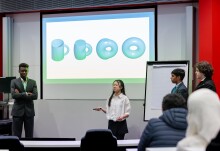

Professor Nicholas Ambraseys died on 28th December 2012 aged 83
Nicholas (Nick) Ambraseys, Emeritus Professor and Senior Research Investigator in the Department of Civil and Environmental Engineering, and long-term member of the College staff, died peacefully at his home in Putney on 28th December 2012 at the age of 83, after a short illness.
Nick first came to Imperial in the early 1950s to study for a PhD and DIC, which were awarded in 1958. He spent the first three years of his academic career as a lecturer at Imperial, followed by a few years in Greece and the USA, returning to Imperial in 1964, where he remained until his death. He became Professor of Engineering Seismology in 1974 and was Head of the Engineering Seismology Section from 1971 to 1994, when he retired. He remained active until the end, holding grants, supervising PhD students and publishing papers; indeed two manuscripts are currently under review by one of the leading journals in his field.
His research covered earthquakes and their effects on the ground, structures and populations. His early work was concerned with the response of earth dams to earthquakes, particularly large dams in the Himalayas (e.g. at Mangla). However, early on in his career he began studying historical accounts of earthquakes, particularly those occurring in the eastern Mediterranean region, and it is in this field where he arguably made his greatest contributions. His meticulous study of historical documents on earthquakes occurring in the eastern Mediterranean and elsewhere (e.g. Central America) is second-to-none and he published many dozens of articles and books on this painstaking work. In 2009 his magnum opus on eastern Mediterranean seismicity, ‘Earthquakes in the Mediterranean and Middle East’), comprising almost 1000 pages, was published. While establishing his reputation as the leading scholar of historical seismicity of the Eastern Mediterranean, he continued to work on the assessment of earthquake ground motions and the collection and analysis of strong-motion (accelorometric) data. Much of this work was conducted within the frameworks of the Strong-Motion Working Groups of the European Seismological Commission and the European Association of Earthquake Engineering, which Nick led for much of the past forty years, work which has been very influential for seismic hazard assessment in Europe and the Middle East.
In all his work he sought to act as a bridge between earth sciences and engineering and between research and practice. His approach was influenced by the knowledge and insights he gained during dozens of post-earthquake field missions in various parts of the world, many of which were under the aegis of UNESCO. These missions led to a series of reports that had an impact on the reconstruction of the earthquake-damaged cities such as Skopje and Managua. His great ability with languages (fluent in three or four and comprehension of many others) was an important factor in sustaining good contacts with people of many nationalities.
In recognition of his lifetime of achievements he was given numerous awards and fellowships from prestigious institutions, for example: Busk Medal for Scientific Discovery from the Royal Geographical Society (1975), Mercenary Award of the European Association of Earthquake Engineering (1975), Fellowship of the Royal Academy of Engineering (1985), Honorary Fellowship of the Society of Earthquake Engineering & Structural Dynamics (1986), Honorary Fellowship of the International Association of Earthquake Engineering (1992), Honoris Causa from University of Athens (1993), Member of the European Academy (1997), Award of the Freedom of the City of Skopje (1998), Harry Fielding Reid Medal of the Seismological Society of America (2006), Fellowship of the Institution of Civil Engineers, Fellowship of the Geological Society and Fellowship of the Royal Geographical Society. From his election in 2003 he was an active member of the First Section of the Academy of Athens and he divided his time between London and Athens.
Nick Ambraseys’ contributions to engineering seismology and earthquake engineering were immense, wide-ranging, covered almost 60 years, and he will be sadly missed. The Department, in particular the Geotechnics Section, are planning to recognise his contribution by organising a memorial to him, to coincide with the 2014 Rankine Lecture, scheduled for 19 March 2014. He is survived by his wife, Xeni.
Article text (excluding photos or graphics) available under an Attribution-NonCommercial-ShareAlike Creative Commons license.
Photos and graphics subject to third party copyright used with permission or © Imperial College London.
Reporter
Angela Frederick
Department of Civil and Environmental Engineering



